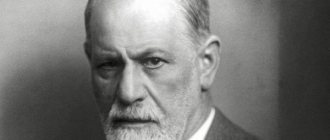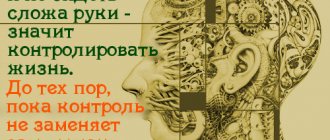Libido
(Latin lĭbīdo - lust, desire, passion, desire) - one of the main concepts of psychoanalysis developed by Freud. It denotes sexual desire or sexual instinct. This term is necessary to describe the various manifestations of sexuality. Freud equated libido with Plato's Eros and defined it as the energy of attraction to everything that is covered by the word “love”: sexual love, self-love (narcissism), love for parents and children, universal love of humanity, etc.
The term “libido” was used by Freud to explain the causes of mental disorders, neurosis, as well as to describe the course of mental development of a normal person, his scientific and artistic activity, and sublimation.
The word lĭbīdo
for the first time [
source not specified 715 days
] found in the work “On the City of God” (14:16) by the theologian Augustine, a saint of the Catholic and Orthodox churches. In the translation of the Kyiv Theological Academy, the term was interpreted as “shameful lust of the flesh”[1].
Libido in Freud's theory
In the process of growing up, the shift in the area of concentration of libido energy throughout the body determines the development of a person. In Freud's theory of psychosexual development, the following stages are defined:[2]
- oral stage (from birth to 0 - 1.5 years) - pleasure from sucking the mother's breast;
- anal stage (from 1.5 to 3 years) - associated with the pleasant sensations received by the child during the excretory activity of the colon and bladder;
- phallic stage (from 3 to 6 years) - sexual exploration, formation of the Oedipus complex in boys and the Electra complex in girls;
- latent stage (from 6 to 12 years);
- genital stage (from 12 years).
Disturbances in the development of libido, according to Freud, lead to mental disorders. Libido underlies all behavior that results in pleasure.
Increased libido
If a health problem already exists, you need to choose a so-called testosterone booster. It is recommended to increase libido in men with the participation of the attending physician, since superficial self-medication can become the main cause of impotence. Here are valuable recommendations from competent specialists:
- To avoid problems with sexual activity, you need to take vitamins and perform training complexes for the prostate.
- To increase libido, you need to ensure a full sleep phase, eat right, completely give up bad habits, and avoid stress and overexertion.
- It would not be a bad idea to practice yoga and meditation, since lack of desire is often associated with internal conflicts and mental contradictions.
- It is not recommended to take sedative herbs, tranquilizers, nootropics, since these medications can cause increased drowsiness and apathy.
- If libidinal energy is reduced, in order to ensure high libido, it is necessary to undergo a course of drug therapy at home.
In men
Libido is enhanced by official and alternative methods, at home and in the hospital, without side effects. In both cases, increasing your own sexuality is required under strict medical supervision, and the following medications are recommended:
- Sealex forte. The herbal dietary supplement contains active ingredients in the form of extracts of ginseng, licorice, yohimbe bark, and green tea. The natural formula has a beneficial effect on erectile function and increases sexual activity. Take 1 capsule with meals every day for 1 month.
- Damiana. A herbal preparation from the category of dietary supplements, which is available in capsule form. The active components increase the sensitivity of the penis and locally stimulate blood flow in the pelvic area. Take 1 tablet with a meal for 1 month.
Libido in Jung's theory
Carl Gustav Jung understands libido as a whole to be psychic energy, or, which is the same thing, the intensity of a mental process [3], and sexuality as only one of the many possible manifestations of this energy, but not as its specific variety. Unlike Freud, Jung considers the similarity of this force with the Eastern concept of Chi or Prana energy, and also traces the roots of this modern concept in the animistic ideas of primitive peoples, which he considered to be undoubted evidence that man has always felt the need to find a concrete form for the dynamism he perceives. mental events[4].
The Nature of LoveErich Fromm
On the origin of sexual perversion
The fantastic idea of a “child being beaten” occurs with astonishing frequency in the confessions of persons who have sought analytic treatment for their hysteria or obsessive-compulsive neurosis. It is quite plausible that it occurs even more often in other people who are not forced to make such a decision by any obvious illness.
Associated with this fantasy are feelings of pleasure, due to which it has been or is still being reproduced countless times [by our patients]. The culmination of the presented situation almost always, as a rule, turns out to be onanistic self-satisfaction, which is initially produced at the will of the fantasizer, but then acquires a certain obsessive character, overcoming his resistance.
The recognition of this fantasy is made only with hesitation, the memory of its first appearance becomes blurred, the analytical treatment of the subject encounters unequivocal resistance, shame and guilt are aroused in this case, perhaps more strongly than with similar reports concerning memories of the beginning of sexual life.
Finally, it can be stated that the first fantasies of this kind were nurtured at a very early period, definitely before entering school, already in the fifth and sixth years of life. When the child then saw at school how other children were beaten by the teacher, this experience again awakened these fantasies to life if they had already fallen asleep, or intensified them if they were still present, modifying their content in a remarkable way. From now on, “an indefinite number” of children were beaten. The influence of school was so clear that patients at first tried to trace their fantasies of beating exclusively to these impressions of the school period, starting from the age of six. But this attempt always turned out to be untenable: the fantasies were already evident before this time.
When the beating stopped in high school, its impact was more than offset by the impressions gained from reading, which quickly became of great importance. In relation to my patients, it was almost always about the same books accessible to young people, from the content of which fantasies of beating drew new impulses: the so-called Bibliotheque rose, “Uncle Tom's Cabin” and the like. Competing with these writings, the child's own imagination began to invent a whole set of situations and institutions in which children were beaten, punished or punished in some other way for their bad behavior and mischief.
Since the fantasy of "a child being beaten" was loaded with intense pleasure and led to an act of autoerotic satisfaction, one might expect that a similar pleasure would come from watching another child being beaten at school. This, however, never happened. Being present at real scenes of beatings at school and the experiences associated with them apparently evoked in the observing child some kind of mixed feeling of very special excitement with a significant degree of condemnation. In a number of cases, the actual experience of scenes of beatings was perceived as intolerable. However, even in the refined fantasies of later years, it was insisted as a condition that no serious harm would be caused to the children being punished.
* * *
We had to raise the question of what relationship exists between the significance of the fantasy of beating and the role that real corporal punishment could play in the home education of a child. The obvious assumption that an inversely proportional relationship could take place here cannot be proven due to the one-sided nature of our material. The people who delivered the material for these analyzes were very rarely beaten in childhood - at least they were not raised with rods. Naturally, each of these children, in one case or another, had the opportunity to feel the superior physical strength of their parents or teachers, and the fact that in any nursery there is no shortage of fights between the children themselves does not need to be emphasized in any special way.
Our research was not averse to extracting more information from those early and simple fantasies, which clearly go back to the influence of school impressions and reading of this period. Who was the child who was beaten? The fantasizer himself or some outsider? Was it always the same child, or as often as not a different one? Who was the person who beat the child? Some kind of adult? And who then? Or did the child fantasize that he himself was hitting another? We did not receive any information that would shed light on all these questions - always only one timid answer: “I don’t know anything more about it; the child is being beaten.”
Inquiries regarding the gender of the beaten child were more successful, but they did not bring any clarity. Sometimes they answered us: “Always only boys” or “Only girls”; more often the answer was: “I don’t know that” or: “It doesn’t matter.” What mattered to the researcher—a certain stable relationship between the gender of the fantasizing child and the gender of the child being beaten—was never recorded. Sometimes another characteristic detail of the content of the fantasy was revealed: “A small child is beaten on his bare bottom.”
Under these circumstances, at first it was impossible to even decide whether to label the pleasure associated with the beating fantasy as sadistic or masochistic.
It is possible to understand such a fantasy, which arises in early childhood, apparently as a result of some random influences and is retained later to obtain autoerotic satisfaction, in accordance with our previous views, only in the sense that we are talking here about some kind of primary trait of perversion. One of the components of the sexual function overtook the other in development, became fixed and, as a result, deviated from later development processes, thereby testifying to a certain special, abnormal personality constitution. We know that such an infantile perversion does not necessarily remain for life; later it can still be repressed, replaced by one or another reactive formation, or transformed under the influence of sublimation. (It is possible, however, that sublimation originates in some special process delayed by repression). But then, when these processes are absent, the perversion persists in adult life, and where we encounter some kind of sexual deviation in an adult - perversion, fetishism, inversion - there we rightfully expect, through amnesic research, to reveal a similar fixing event in childhood period. And long before psychoanalysis, observers like Binet traced the strange sexual deviations of the mature period to similar impressions of the same five or six years of age. However, at the same time we ran into the limits of our understanding, because the fixing impressions lacked any traumatic force, for the most part they were banal and did not in any way excite other individuals; it was impossible to say why sexual desires were fixed on them. But their meaning could be sought precisely in the fact that they provided - even if only accidentally - a reason for fixing a premature sexual component ready for a leap, and we had to prepare for the fact that the chain of causal connection would break prematurely somewhere. It was the innate constitution that seemed to fit the bill to [explain] such a breaking point.
If the prematurely detached sexual component is sadistic in nature, then, based on the knowledge we have already achieved, we can expect that as a result of its later repression, a predisposition to obsessive-compulsive neurosis will be created. It cannot be said that the result of our research contradicts this expectation. Among the six cases on which this short article is based on a detailed study (four women, two men), there are cases of obsessive-compulsive neurosis - one very severe, life-threatening, and one of moderate severity, well accessible to [therapeutic] influence, as well as a third, in which at least some obvious features of obsessive-compulsive neurosis were present. The fourth case, however, was pure hysteria with pain and inhibition, and in the fifth case the person turned to the analyst for help only because of the indecision from which he suffered in his life, and this case would not be classified at all by a rough clinical diagnosis, or she would have gotten rid of him by labeling him some kind of “psychasthenia.” Such statistics cannot in any way disappoint us, because, firstly, we know that not every predisposition necessarily develops into a disease, and secondly, we have the right to be satisfied with explaining what is present, and generally avoid the task of understanding also why nothing happened.
Until now, and no further, our present knowledge would have allowed us to penetrate into the understanding of the beating fantasy. The suspicion that the problem does not end with this stirs, however, in the brain of the medical analyst when he has to admit to himself that these fantasies for the most part remain aside from the other content of the neurosis and do not occupy any suitable place in its structure; but usually, as I know from my own experience, such suspicions are readily brushed aside.
* * *
In a strict sense - why not consider this as strictly as possible? - only such an analytical effort deserves recognition as a correct psychoanalysis, which managed to eliminate the amnesia that envelops an adult's knowledge of his childhood life (that is, from approximately two to five years). Among analysts, this simply cannot be talked about too loudly or too often. The motives that force one to ignore such an admonition are, of course, understandable. I would like to achieve useful results in the shortest possible time and with the least amount of effort. But at the present time, for each of us, theoretical knowledge is still incomparably more significant than the therapeutic result, and anyone who neglects the analysis of the childhood period necessarily falls into the most serious delusions. This emphasis on the importance of the earliest experiences does not lead to an underestimation of later ones; but later life impressions express themselves quite loudly when analyzed through the lips of the patient, and none other than the doctor should raise his voice for the rights of childhood.
The period of childhood from two to four or five years is the time when innate libidinal factors are first awakened under the influence of certain experiences and are associated with certain complexes. The fantasies of beating discussed here appear only towards the end of this time or upon its completion. They, therefore, may well have some kind of prehistory, undergo a certain difference, correspond to the final result, and not to the initial manifestation.
This assumption is confirmed by the analysis. Its consistent application makes it possible to find out that beating fantasies have a very complex history of development, during which much in them changes more than once: their relationship to the fantasizing person, their object, content and meaning.
To make it easier for us to trace these transformations to which fantasies of beating are subjected, I will now allow myself to limit my description to females, who already (four to two) make up the majority of my material. In addition, another topic is connected with fantasies of beating in men, which I would like to avoid in this article. At the same time, I will try to schematize no more than is necessary when depicting the average case. And even if subsequent further observation provides a greater variety of cases, I am still confident that I was able to capture some typical and by no means rare event.
Consequently, the first phase of beating fantasies in girls must date back to a very early period of childhood. Something about them remains remarkably vague, as if it were indifferent. The paucity of information received from patients at their first message “The child is being beaten” seems to be justified in the fantasy of this [phase]. But another feature is defined quite clearly, and in the same spirit. Namely, the child who fantasizes never appears to be the one being beaten; it is, as a rule, some other child, most often a brother or sister, if there is one. Since this can be either a boy or a girl, it is impossible to derive any stable relationship between the gender of the fantasizing and the beaten child. Fantasy is thus definitely not masochistic; it could be called sadistic, but we have no right to lose sight of the fact that the fantasizing child himself never acts as a beater. About the latter, we can only say that this is not another child, but some kind of adult. Later, this unidentified adult is clearly and unequivocally recognized as (the girl's) father.
* * *
So, this first phase of the beating fantasy is completely conveyed by the following statement: “The father beats the child.” I would be giving away much of the content [of the fantasy] that has yet to be revealed if I were to say instead: “The father beats the child I hate.” However, one can hesitate as to whether we should already recognize the nature of some kind of “fantasy” behind this preliminary stage of the later fantasy of beating. Perhaps we are talking here, rather, about certain memories of similar events that [the patients] witnessed, about desires that were caused by certain reasons, but these doubts have no meaning.
Between this first and subsequent phases, significant changes occur. Although the role of the beater is still played by the father, the role of the beaten one is now played, as a rule, by the fantasizing child himself; fantasy now has a distinctly hedonistic character and is filled with important content, the origin of which we will deal with later. She now expresses herself in the words: I am being beaten by my father. She is undoubtedly masochistic in nature.
This second phase is the most important of all, and it is the one with the most consequences. But, in a certain sense, we can say about it that it never had a real existence. In none of the cases is she remembered; she never managed to break through to awareness. It is an analytical construct, but that does not make it any less necessary.
The third phase is similar to the first. Her verbal expression is known from the patient's report. The father never acts as the beating person, the latter is either left undefined, as in the first phase, or is typically loaded with some kind of father's substitute (teacher). The fantasizing child himself no longer appears in the fantasy of beating. To my persistent questions about this, the patients only answer the following: “I’m probably observing.” Instead of one child being beaten, there are now many children in most cases. Most often, those who are beaten (in girls' fantasies) are boys, but not those they know personally. The initially simple and monotonous situation of beating can now be modified and embellished in a wide variety of ways, and the beating itself can be replaced by punishments and humiliations of a different kind. But the essential character that distinguishes even the simplest fantasies of this phase from those of the first phase and which connects it with the middle phase is this: the fantasy is now the bearer of strong and unambiguous sexual arousal and, as such, contributes to the achievement of onanistic satisfaction. But this is precisely what seems mysterious: in what way does the sadistic fantasy from now on that some strangers and unknown boys are beaten, henceforth receive into its permanent possession the libidinal aspirations of a little girl?
We do not hide from ourselves the fact that the interconnection and sequence of the three phases of the beating fantasy, as well as all its other features, have so far remained completely unclear.
* * *
If we carry the analysis through those early times to which the beating fantasy is traced back and from which it is extracted by memory, then it will show us a child captured by the impulses of his parental complex.
The little girl fixates with tenderness on her father, who has obviously done everything to win her love, and in doing so plants the seed from which will arise an attitude of hatred and rivalry towards the mother, remaining along with a stream of tender affection for her; Over the years, this attitude may be destined to become stronger and more clearly recognized, or to give impetus to some kind of excessive reactive loving attachment to the mother. There are also other children in the nursery, very little older or younger, whom they do not want to tolerate for many different reasons, but mainly because they have to share the love of their parents, and who are pushed away from them with all the indomitable energy that is characteristic of emotional life of these years. If we are talking about a younger child, a brother or sister (this was the case in three out of four of my cases), then he is not only hated, but also despised, and the older child has to watch how he attracts the lion's share to himself the tenderness that blinded parents are always ready to give to the youngest. It soon becomes clear that beating, even if it does not hurt very much, means denial of love and humiliation. Thus, more than one child, who considered himself securely established in the unshakable love of his parents, was toppled from the heavens of his imagined omnipotence with a single blow. Thus, the idea of the father beating this hated child is pleasurable quite independently of whether he was actually seen beating him. This means the following: “The father does not love this other child, he only loves me.”
This, then, is the content and meaning of the beating fantasy in its first phase. Fantasy clearly satisfies the child's jealousy and is dependent on his love life, but it is also strongly reinforced by the child's selfish interests. Consequently, it remains doubtful whether we have the right to designate it as purely “sexual”; Nor do we dare call it “sadistic.” After all, it is known that all the signs on which we are accustomed to base our distinctions usually become vague closer to the source. So this seems to be reminiscent of Banquo's three witches prophecy: [fantasy is] neither distinctly sexual nor even sadistic, but represents the material from which both must later emerge. However, none of the cases gives reason to assume that even this first phase of fantasy serves the excitement that learns to be discharged through the use of the genitals in the act of masturbation.
In this premature choice of the object of incestuous love, the sexual life of the child clearly reaches the stage of genital organization. In the case of a boy this is easier to prove, but in the case of a girl it is undeniable. The libidinal striving of the child is dominated by something like an anticipation of later final and normal sexual goals; It is appropriate to express surprise at where it comes from, but we have the right to accept it as evidence that the genitals have already begun to play a role in the process of arousal. The desire to have a child with his mother is always present in a boy, the desire to have a child from his father is invariably present in a girl, and this is despite the complete inability to clarify for herself how this desire can be achieved. That the genitals should have something to do with this seems to be beyond doubt for the child, although his reflections on this matter may lead him to look for the essence of the intimacy assumed between the parents in other kinds of relationships, for example, in the fact that they sleeping together, urinating together and the like - and such content is easier to grasp in verbal ideas than the vague ones associated with the genitals.
* * *
The time comes when these early flowers wither from frost: not one of these incestuous loves can escape the fate of repression. They are subjected to it either due to certain external reasons that can be traced and which cause some disappointment, during unexpected insults, during the unwanted birth of a new brother or sister, perceived as infidelity, or without such reasons, from within - perhaps only due to the simple lack of its completion, which has been languishing for too long. It is impossible not to admit that these reasons are not real reasons, but these love attachments are destined to die someday, and we cannot say why. Most likely, they fade away because their time is running out, because children are entering some new phase of development in which they must repeat the repression of the incestuous choice of object that has occurred in human history, just as they were previously forced to make such a choice. What is unconsciously present as a mental result of incestuous love impulses is no longer adopted by the consciousness of the new phase, but what was already conscious in them is again pushed aside. Simultaneously with this process of repression, a consciousness of guilt also appears - its origin is also unknown, but it is undoubtedly connected with these incestuous desires and is justified by their continuation in the unconscious.
Notes
- Augustine the Blessed.
About the City of God. Part 3-5 // Works of Blessed Augustine, Bishop of Hippo = De civitate Dei ad Marcellinum / trans. Kyiv Theological Academy. — Ed. 2nd. - K.: Printing house of I. I. Cholokov, 1905-1910. - Z. Freud. “Phases of development of sexual organization” - S. Freud. Essays on the psychology of sexuality / Trans. from English M.: Azbuka, 2010, P.56
- Jung K. G. Psychological types / Transl. with him. Sofia Lorne / Under the general editorship. Zelensky V. - St. Petersburg: “Juventa”; -M.: Publishing House, 1995. - 718 p.
- C. G. Jung, “On Psychic Energy” - C. G. Jung. Structure and dynamics of the psyche / Transl. from English - M. “Cogito-Center”, 2008, p. 78.
Reasons for decreased sexuality
Sexual desire is affected by a number of psychological and physiological conditions, and such changes are not for the better. For example, it is possible to restore sexual desire in case of hormonal pathologies using pharmaceutical methods, but you can really get rid of critical emotional states only at an appointment with specialists, a sexologist. Before starting effective therapy, it is necessary to reliably identify the cause of the deterioration in general well-being, decrease in sexual desire, and then eliminate the provoking condition.
Reasons for decreased libido in women:
- Changes in hormonal levels – hormone imbalance. This depends on the woman’s menstrual cycle and other biochemical processes in the body. A decrease in sexual desire in women can also be noted during menopause.
- Unbalanced diet, addictions.
- Lack of self-confidence and self-attractiveness. Excessively strict upbringing in childhood can be the cause of many complexes that prevent a woman from opening up to her partner. As she ages, she may even avoid intimacy due to age-related changes.
- Diseases, use of certain medications.
- Stressful and depressive states, overexertion.
- Loss of emotional connection with a partner. In women, sex and emotions are closely related to each other, and the lack of sexual desire in women is quite natural if she does not feel a spiritual kinship with her partner.
Reasons for decreased libido in men:
- Unbalanced diet, poor nutrition, excessive drinking, smoking. Alcohol and smoking reduce the level of testosterone in the body, which leads to pathologies in the functionality of the gonads. All this causes disturbances in the receptivity of the spinal cord center and, as a result, a reduction in sexual desire in men is observed, the signs of which are expressed in a reluctance to have sexual contacts.
- Age period of the man. The older he gets, the less libido he gets.
- Obesity. Fat suppresses the production of male hormones and activates the production of female ones. In addition, an obese man is simply too lazy to move, it’s difficult for him, and the load on the cardiovascular system increases.
- Diseases and drug use.
- Hormonal imbalance.
- Psychological disorders, lack of self-confidence, fear of being ridiculed by a partner. For men, penis size and the likelihood of having sex for a long time play a big role. If he is unsure of these skills, he will avoid sexual contact.
- Stressful situations, fatigue, depression. Difficulties and conflict situations in the workplace and in the family have a negative impact on male libido.
Links
Wiktionary has an entry for "libido"
- Libido
- article from the Great Soviet Encyclopedia. - Libido - Small Medical Encyclopedia. — M.: Medical encyclopedia. 1991-96
- Libido - Leibin V. Dictionary-reference book for psychoanalysis, 2010.
- Libido - C. Rycroft. Critical Dictionary of Psychoanalysis.
- Libido theory - Psychoanalytic terms and concepts. Dictionary, ed. Borness E. Moore and Bernard D. Fine.
- Modern theory of libido in psychoanalysis
| This is a draft article on psychology. You can help the project by adding to it. |
Reviews
Dear readers, your opinion is very important to us - therefore, we will be glad to receive feedback on what libido is for you according to Freud in the comments, this will also be useful to other users of the site.
Inna:
The right lifestyle and your libido will be fine. Particular attention should be paid to diet. More seafood, spices and herbs, nuts and dried fruits. I always try to regularly use such products in the diet of my husband and myself. In addition to normal libido, they are also good for health.
Ksenia:
With such a delicate problem, the doctor recommended that I take vitamins A and E, since they are of particular importance for the human body and its systems. I bought these vitamins at the pharmacy and noticed that my appearance improved, my hair and nails became better, and my sexual energy knew no bounds.










